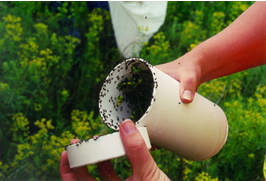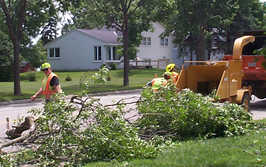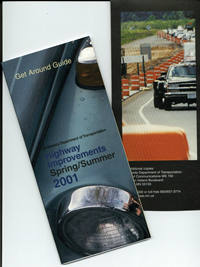 |
 |







|
 |
 |
 |
 |
 |
 |
 moving minnesota through employee communication moving minnesota through employee communication |
 |
 |
 June
20, 2001 June
20, 2001 |
No. 19 |
 |
|
|
 |
 |
 |
Meet the beetles!
|
 |
 |
 |
|
Beetles have gone on
"weed control" in place of spraying efforts at the I-90/Hwy
63 interchange north of Stewartville. Photo by Brian Jergenson
|
. . .not Paul, George or Ringo—but an insect that will help control infestation
of leafy spurge.
On June 14, the Rochester district released 50,000 beetles at the I-90/Hwy
63 interchange just north of Stewartville. The beetles are being used as an
alternative to chopping or spraying the weed that has the ability to overgrow
other, more desirable vegetation.
Using beetles is cost-effective and Mn/DOT can forego the use of herbicide.
With spurge under control, a more diverse landscape develops because other plant
communities are not crowded out. Because the beetles only feed on spurge and
do not eat wildflowers or garden plants, when the spurge numbers decline, so
do the beetles.
For more information, contact Brian Jergenson, Rochester public affairs coordinator,
507/285-7364.
|
back

|
 |
Storms keep Mn/DOT maintenance crews busy (again)
|
 |
 |
 |
Crews from the Hutchinson
and Olivia truck stations cleanup Hwy 22 on the south end of Litchfield.
From left are Roger Wersal, Hutchinson, Jim Steinbeisser, Olivia, and
Adrian Garcia, Olivia. The chipper is on loan from the Renville County
highway department. Photo by Dave Johnston
|
The storms that rolled through central and west central Minnesota the week
of June 11 kept maintenance crews from the Brainerd, Detroit Lakes and Willmar
districts busy clearing trees and building debris from numerous highways throughout
the districts.
Heavy
rainfall caused water to flow over Hwy 27 in three locations between Lastrup
and Isle—and had workers from the Little Falls truck station scurrying to install
signs to warn motorists of the water hazard ahead. In addition, the Aitkin sub-area
worked overnight clearing trees which blocked Hwy 47 between Aitkin and Malmo.
And debris and trees on Hwy 23 and Hwy 25 near Foley required an all-out effort
from the Milaca truck station.
Hwy 12 seemed to provide a conduit for tornado and storm
activity through the Willmar district. The storm touched down in Benson (Detroit
Lakes district) and then moved through the Spicer area and back along Hwy 12
through the cities of Atwater, Grove City, Cosmos and Litchfield. In addition
to heavy damage to homes and businesses along its path, the storm dropped trees
and other debris on area roadways to keep maintenance crews in the district
working hard for many hours.
And just when this spring’s flooding was fading from memory in the Detroit
Lakes district, portions of several roadways were covered with water and some
roads were closed to traffic. A section of Hwy 79 near Erdahl was flooded with
nearly three feet of water over the road. The roadway is scheduled for reconstruction
to raise it six feet above the current grade. Water also made travel more treacherous
on Hwy 27 and Hwy 9 near Herman, and on Hwy 12 near Ortonville and Hwy 29 north
of Parkers Prairie.
Maintenance
forces in the Twin Cities Metro area also dealt with the aftermaths of severe
thunderstorms. Heavy rain caused water to flow over
roadways in many locations, including along sections of I-94, I-35W and I-494.
By Kent Barnard
|
back

|
 |
Get around guide available now
|
 |
 |
 |
|
The Get Around Guide will do some traveling itself
this summer as travelers pick up their guides from any of several hundred
locations around the state.
|
The spring/summer issue of Mn/DOT’s Get Around Guide is now available
for summer travelers of Minnesota roadways. The guide is designed to help travelers
avoid highway construction projects and reduce frantic encounters with detours
and road restrictions as they trek through Minnesota this summer. The guide
lists more than 150 major projects, their start dates and traffic restrictions.
It also advises motorists to plan ahead and to understand the need for the work
being done on the state’s highways.
Travel information centers, chambers of commerce and gas stations will be distributing
the guides. In addition, Mn/DOT’s Information Center, located on the first floor
Central Office building, has copies of the 2001 Get Around Guide available.
The 2001 Get Around Guide also will be available on Mn/DOT’s Web site
soon. The Web site will have the most current information about the status of
road improvement projects. Updates and project completions will be pasted weekly.
For more information, contact Mary Meinert at 651/297-5868.
By Mary Meinert
|
back

|
 |
Groundbreaking heralds creation of shared transportation facility
|
 |
 |
Officials from Mn/DOT, Clay County and the city
of Moorhead gathered on June 18 to turn earth at the site in Moorhead, which
will eventually become the area’s Joint Public Works Facility.
When completed in March 2002, the facility will house the Clay County Highway
Department, storage and office space for the city of Moorhead and the Detroit
Lakes District’s Dilworth Technology Center.
The facility follows the pattern set by other joint-use facilities, such as
those at Hutchinson and Hibbing, which allow agencies to share resources and
reduce costs when compared with constructing separate facilities.
The facility will, for example, provide savings for Mn/DOT and the county from
bulk purchases of sand and salt and sharing of some equipment. Housing the agencies
together will also increase the exchange of expertise among staff members and
allow staff sharing across jurisdictions in times of emergencies.
The new building will provide more than 66,000 square feet of space for the
three agencies. The cost is $5.5 million.
Doug Weiszhaar, Mn/DOT’s deputy commissioner, and Lee Berget, Detroit Lakes
district engineer, joined city, county and officials at the groundbreaking ceremony.
By Craig Wilkins
|
back

|
 |
New program, project management system
replaces Artemis
|
 |
 |
Mn/DOT took a significant step forward in its efforts to streamline program
delivery with the release June 14 of the new Program and Project Management System.
PPMS replaces the Artemis 9000/EX LAN system.
“The release of the PPMS is an important milestone in helping
us streamline program delivery and achieve our information strategic objective,”
said Deputy Commissioner Doug Weiszhaar.
PPMS includes schedules, costs and locations of projects
in the three-year State Transportation Improvement Program, in the districts’
three-year work plans and four-year studies plans, according to Susan Bousquet,
PPMS project manager. It covers all trunk highway projects. It also covers state
aid, rail, transit and Intelligent Transportation System projects that include
federal funding.
“The system is vital to ensuring Mn/DOT stays on track delivering the transportation
improvement program,” Weiszhaar said.
This first release of the PPMS provides all the functionality
of the Artemis 9000/EX LAN system it replaces, Bousquet said. It also contains
new project "header" and cost estimate data plus estimates of human resource
requirements by functional group.
“Like Artemis 9000/EX LAN, PPMS is focused on identifying
activities on the critical path to project letting, and monitoring whether projects
are staying on schedule,” she said. “Other systems will gradually come to rely
on PPMS data rather than capturing redundant and potentially conflicting project
data.”
Several additional modules are in development and will
be rolled out over the next several months. District coordinators have received
PPMS training. As the additional modules/enhancements are developed, training
will be provided for functional group leaders and project managers.
“PPMS reports will help district and central office managers
deliver the transportation improvement program in line with citizen and legislative
expectations and make decisions that help streamline the program delivery process,”
Weiszhaar said.
For more information about PPMS, contact Sue Bousquet at 651/296-3113 or Jim
Weingartz at 651/296-9146. See also the Project
Management Unit Web site.
|
back

|
 |
Employee information now online
|
 |
 |
Information about the marriages, births, retirements, funerals and other milestones
of your Mn/DOT co-workers is available online by clicking on “Employee Info”
on the left hand navigation bar of Mn/DOT Newsline.
Also included in Employeeline
are listings of events of interest to Mn/DOT employees. Today’s edition, for
example, carries information about the national Workplace Safety Week, June
24-30.
Readers outside of Mn/DOT will not be able to access Employeeline, which
is located on the department’s internal Web site. Plans are in the works to
make this information available to Mn/DOT retirees soon through another format.
|
back

|
 |
Question of the Week
|
 |
 |
Question: “Mn/DOT does a lot of research. Many kinds of research. What
are the differences in technical and non-technical; traffic forecasting and
market research, and research services, etc.? And how much of this actually
determines what happens? When the public gives its opinions, does Mn/DOT really
do anything with that information? How does the average citizen find out what
Mn/DOT knows?”
Answer:
Yes, you are correct. Mn/DOT is a data-driven environment; and we have a lot
of data from research we conduct. The kinds of research we do fall into these
two areas:
§
Market research (customer opinions, expectations, satisfaction
measures, etc.)
§
Transportation research (materials, traffic patterns, vehicle
miles traveled, etc.)
Both types of research involve technical and non-technical approaches and subjects
of research. We use market research to set Mn/DOT’s future direction in order
to best serve our customers and monitor our progress. We conduct transportation
research to develop new tools and knowledge so that Mn/DOT employees can more
effectively move in this future direction.
This week, we will start with market research and with examples
of customer research and how Mn/DOT uses it to set directions and make specific
improvements. We will also talk to key experts in transportation research for
a future installment.
Here's what we learned from Karla Rains, Market Research:
“Mn/DOT is ‘data-rich’: we have all kinds of data on what
people do. Market research focuses on:
§
Why people do what they do (understanding the motivations behind
those choices),
§
What they expect from us as an agency, and
§
How well we’re delivering on those expectations (“satisfaction”).
“Basically, market research is the voice of the customer.
Our research supports and guides Mn/DOT's decisions, both on a strategic and
a tactical level.
“One example of how Mn/DOT uses market research data is the
market segmentation study (“Segmentation Service Value Study”) that we conducted
in 2000. In this study, we learned:
§
How different segments of the public value each of the services
we provide,
§
Where our customers think we still need to improve, and
§
Where we are exceeding their expectations.
“In cases where we are perceived as over-performing, we learn where we could
divert resources into other areas.
“For this fiscal year, Mn/DOT asked the divisions and districts
to review the segmentation data before submitting their business plans and budgets.
This means that, on a strategic big-picture level, what our customers told us
really is helping us to set our business direction.
“Mn/DOT has also used customer data tactically on a project-related level.
We've done a lot of studies where the data has been used to help make customer-driven
changes such as road signage, snow plowing, traffic incident management, and
so on.”
Click here to read the full response to
the market research question and to view previous questions of
the week.
|
back

|
|
 |
|
|


